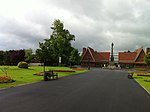Clock Tower, Crewe
1888 establishments in EnglandBuildings and structures in CreweClock towers in the United KingdomGolden Jubilee of Queen VictoriaGrade II listed buildings in Cheshire ... and 3 more
Individual clocks in EnglandTowers completed in 1888Towers in Cheshire

The Clock Tower stands near the north entrance to Queen's Park, Crewe, in Cheshire, England. The park was given to the residents of the town by the London and North Western Railway Company, and the clock tower was paid for by its employees. It was unveiled on the same day the park was officially opened in 1888. The tower is built in sandstone and brick, and contains medallions with the heads of Queen Victoria and officials of the company. It is recorded in the National Heritage List for England as a designated Grade II listed building.
Excerpt from the Wikipedia article Clock Tower, Crewe (License: CC BY-SA 3.0, Authors, Images).Clock Tower, Crewe
Victoria Avenue,
Geographical coordinates (GPS) Address External links Nearby Places Show on map
Geographical coordinates (GPS)
| Latitude | Longitude |
|---|---|
| N 53.09843 ° | E -2.46761 ° |
Address
Clock Tower
Victoria Avenue
CW2 7SG , Coppenhall
England, United Kingdom
Open on Google Maps









